Back to page 1
The Design

Despite the exterior of Globe Life Field feeling so enormous, the Rangers gave the architects at HKS a simple directive: make the interior feel intimate.
That’s not asking for much when the total size of your structure is 1.8-million square feet (400,000 square feet more than Globe Life Park), is it?
“The Rangers had this mentality of creating a backyard feel,” HKS’s Fred Ortiz, the Lead Designer on the project, told us. “It is home-like here. It’s very comfortable and welcoming.”
How is that accomplished when there needs to be seating for over 40,000 and there are seven different seating levels? You make each area inside the park a place where fans want to visit and congregate. “There’s a great variety of destinations in the venue,” Ortiz continued. “Fans should make a point of experiencing the stadium from all of the vantage points we’ve created.
“There are two 360-degree concourses. Some of the best vantage points aren’t at your seat, so get up and walk around. Make note of all of the nooks and crannies.”
HKS’s Bryan Trubey, who was considerate with his time in giving me a tour of the field-level features of the park, served as the Principal Designer. It was his guiding hand that steered the overall design process. He pushed the envelope of stadium design in getting the seats as close to the field as possible. His model when it came to intimacy was Wrigley Field. Considering that I think Wrigley is the greatest structure man ever designed, that was a great role model.
The sense of intimacy in the Rangers’ new home is helped in two key ways: the capacity is about 8,000 smaller than its predecessor across the street; and the seats are closer to the field. Regarding the latter, advances in engineering from when Globe Life Park was designed in the early 1990s were a big help.
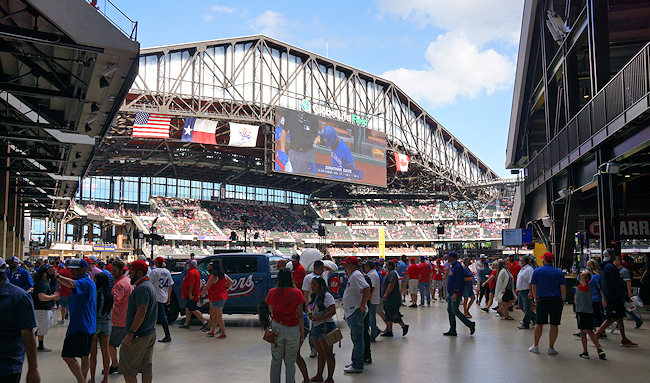
For instance, the upper concourse (see the photo at the top of this page) — which surrounds the playing field 360 degrees, unlike at Globe Life Park — is 184 feet from the field surface. At the old park, it was 207 feet away. The lower concourse (see above) is 160 feet from the field, while across the street it was 174 feet.
And in a daring move — especially for a team that needs to manufacture runs with its running game — the backstop is now only 42 feet from home plate, while it was the normal 60 feet across the street.
While we’re talking about distances, let’s look at the outfield dimensions.
The Rangers cared a great deal about the dimensions because it was an opportunity to honor players whose uniform numbers have been retired, in addition to mounting large numbers on columns high above left field. Moving from left field to right: the LF line is 329′, to honor Adrian Beltre’s #29; there’s a distance marker in left field at 334′ spot to honor Nolan Ryan’s #34; the LF power alley is 372′, because the Rangers first year in Texas was 1972; just to the left and right of dead CF it’s 410′, to honor Michael Young’s #10; dead CF is 407′, to honor Pudge Rodriguez’s #7; the RF power alley is 374′, to celebrate the “turnaround” 1974 team that won 27 more games than the previous year; the RF line is 326′, to honor late manager Johnny Oates’ #26.
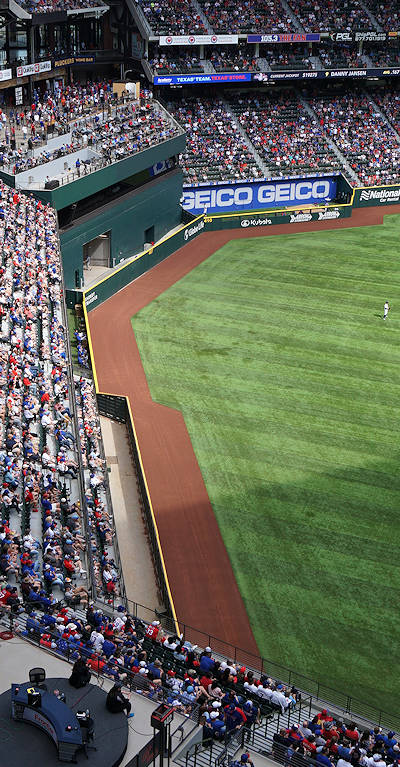
But Jackie Robinson’s number is retired in every park you say. Why isn’t he honored? He is: remember that it’s only 42′ from home to the backstop? The man who broke the color barrier wore #42.
I don’t think all of this is necessarily a good idea. When you have all of these contrived dimensions, you end up with outfield fences that jut in and out (see photo). Some of that is fine. Anything is better than the symmetrical, rounded outfields of the cookie-cutter parks of half a century ago.
But I’m not a fan of this many variations in an outfield wall. Now, the all-time worst is Minute Maid Park in Houston, where the walls go up, down, in and out so many times it makes me dizzy. Globe Life Field isn’t nearly as bad as that, but I’d prefer fewer variations in the outfield dimensions.
Despite the numerology and intimacy of the interior, without a doubt the two characteristics of the stadium that are discussed the most are actually quite related: the retractable roof and air conditioning. You can’t have one without the other … but interestingly, you can have AC with the roof open!
First, as we’ve discussed, the roof is a massive thing — and it’s all in one piece. Unlike in Seattle, Phoenix or the aforementioned Houston, this roof isn’t in multiple panels. No, in Arlington it is in a single panel that encompasses 5.5 acres, making it the largest single-panel operable roof in the world. Once again, the phrase “everything is bigger in Texas” is proven true. When it “retracts” (slides open), the panel opens over right field and moves toward the third-base side of the park. So when the roof is open, the enormous panel is actually resting on its tracks high above a part of the park’s exterior fans rarely see, on the west side. Other than VIP entrances, fans don’t typically enter the facility on that side.
During the late afternoon and early evening when the roof is open, that means the sun is in the eyes of those in the lower decks of right field. Conversely, sections on the third-base side — especially farther from the field — can seem pretty dark (see photo below), because that area is always covered whether the roof is open or closed.

The roof itself is quite a feat of engineering. The outermost area (that is, the very top layer) is comprised of two main materials covering three flat surfaces. The sloped (outer) planes are a light-blocking rubber material while the flat (middle) plane is comprised of 223 panes of a clear plastic polymer called ETFE. This allows diffused natural light to enter the stadium even when the roof is closed. Of course, light also enters through the glass outer wall beyond left field and at the ends of the roof panel. Supporting the outer layer of the roof are five steel trusses with additional steel joining those trusses.
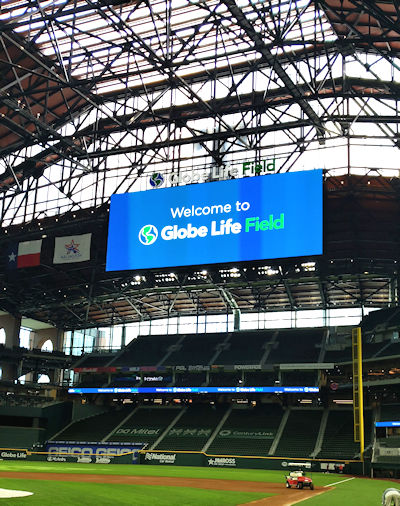 In case you’re at the ballpark when the roof is opening or closing, and you’re wondering about the weight of that panel that is sliding overhead, it’s 12,000 tons. Maybe it’s better not to think about it.
In case you’re at the ballpark when the roof is opening or closing, and you’re wondering about the weight of that panel that is sliding overhead, it’s 12,000 tons. Maybe it’s better not to think about it.
To give credit where it’s due, HKS’s Principal In Charge John Hutchings was quite involved in the design of the roof. It is certainly a marvel of engineering.
The Rangers are in charge of whether the roof is open or closed for any given game. The guidelines they follow are these: if the outside temperature is above 80 or below 65, or there is a threat of rain or winds above 20 mph before the anticipated end of the game, the roof will remain closed throughout the contest.
I was in the pressbox during the second regular-season game played here in July 2020. Even though it was quite hot outside, the game started with the roof open. I assumed the temperature around me would zoom upward the longer we were open to the sky, but that’s not what happened. We remained at a comfortable temp throughout.
I figured that, hey, heat rises and cool air sinks, so that’s why it remained so comfortable. Wrong. Thomas Smith, Senior Project Architect on the ballpark, explained to me that the heating and cooling system was designed to pump warm or cool air through the vents even with the roof open. I was amazed, to say the least.
Talk about having the best of both worlds!
Let’s now look at how the ballpark is organized from the standpoint of its concourses. The lowest level isn’t accessible to fans unless you can show a ticket for suites or seats there. In fact, you would have to enter the ballpark on the main concourse level, then descend down stairs, escalator or elevator to reach that concourse. This is how you get to the seating sections with two digit numbers and the field suites. It’s also where you’d find the StubHub Club and the Balcones Speakeasy club.
The main concourse rings the playing field, and is where the entryways place you once you enter the park from any side of the building. The largest merchandise store is beyond center field on this level, as are food courts near the right field foul pole, behind first base and a really impressive one behind third base. The 100-level seating sections are here, as is the office and public-address booth for Executive VP of Ballpark Entertainment Chuck Morgan, directly behind home plate.
  |
“I gave the architects an idea,” Morgan explained to us. “Back in the day when I was a kid going to games at Sportsman’s Park (in St. Louis), announcer Charlie Jones was right behind the plate, where he could use a megaphone to announce the changes to the crowd. The architects then put me right behind home plate on the main concourse in what I call a Pope Bubble. People can see inside and I can come out and shake hands with the fans.”
This is quite a spot to visit, not only because you can look through the glass walls and watch Morgan at the mic during the game, you can also examine display cases with memorabilia that he’s collected over his decades in the radio and baseball businesses. And he loves to pop out to meet fans.
 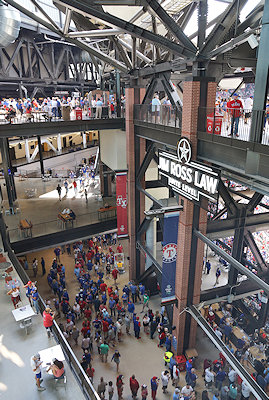 |
| An entire book could be written on the “geometry” of Globe Life Field. If the geometry isn’t right — with correct sight-lines and spacing of seating sections — then none of the engineering matters. On the left you see the way the seating levels are arranged behind home plate. In the extreme upper left of the shot is the pressbox (yep, there is no glass between the writers and the ballpark’s interior) and directly below it are the broadcast booths, which are in a similar position as in Globe Life Park. The other shot shows the fascinating use of space under the stands, which is particularly true in the outer corners of the building. This scene is near the right-field foul pole. |
Going up another level puts you on the Jim Ross Law Suite Level (more on all the branding around the park in a minute). This is how you access the 200-level suites — although without a ticket here, you can’t roam around on this level.
Another level up is the Upper Concourse, which wraps the field 360 degrees. This is where you access the 200-level seats (in front of you) and the 300-level sections (over top of the concourse). Behind first base is a food court, and behind it is the all-you-can-eat dining room. You can’t see the field from here, but you receive a ticket for a seat when you buy this service.
  |
| The Karbach Sky Porch is a must-visit spot. On the lower of its two levels is an always crowded food and drink area with rocking chairs just outside, and on the upper level is a lounge area with patio furniture and along its railing is a top-of-the-world view that can’t be beat. |
In the left-field corner is the two-level Karbach Sky Porch, which serves food (specialty is brisket in mac ‘n cheese), drinks and rocking chairs to watch the action below.
The Oatly Kid’s Zone is in center field on this upper concourse, complete with bigger-than-life bobble heads of Rangers players. A definite photo opportunity. While here, wander up the steps to a two-level perch that gives you an unrivaled panoramic view of the ballpark.
 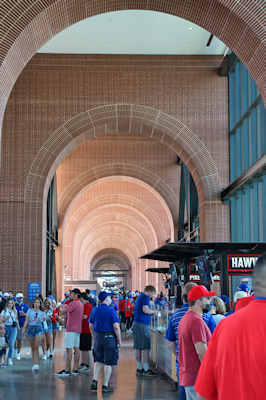 |
| More on the impressive geometry. The first image above was taken from the upper concourse between the upper deck in right field and the southeast exterior wall. I think this is a tremendous use of space while permitting natural light to enter the area. HKS’s Bryan Trubey was the driving force in opening up these areas so natural light could reach all the way down to the main concourse. The other photo shows the 1,000-foot “bridge” concourse with its 18 arches on the upper deck above left field. Another must-visit spot in the ballpark. |
You need to make a point to walk along the concourse between the Sky Porch and the Kid’s Zone. Here you are directly underneath the tracks for the retractable roof, so there is a straight shot of 1,000 feet that is my favorite spot in the park. It took 650,000 bricks to construct the 18 arches that you walk through here. On the field side are so-called “bridge seats” in sections 240-244 (the pitch is a little on the steep side) that provide a phenomenal view of the stadium’s interior (although not so great of the left-field wall), and on the other side is a wall of glass that allows you to look down at Texas Live! and across the street at Globe Life Park. This area almost gives you sensory overload, but in a wonderful way. You really need to visit it.

Naturally, when asked his favorite feature the ballpark, Ortiz quickly replied, “The north wall with the arches is my favorite design element. It contributes to a lot of the design drivers, especially the transparency. It extends the room. It pushes it out while conversely, the outdoors come in.” The photo above shows the north wall from the field.
Minute Maid Park in Houston has a similar area that runs underneath the track for its retractable roof, but it is not nearly wide enough so there is always congestion there. And because it’s on the level of the main concourse, you don’t have the opportunity to look outside and see the Houston skyline, although you can look onto the playing field.
Speaking of playing fields, the one at Globe Life Field is artificial. It wasn’t necessarily meant to be that way. When the HKS design team went to work in figuring the layout for the ballpark, the Rangers told them to do so to accommodate natural grass, even though there was a good chance they would ultimately opt for an artificial surface.
So HKS did the sun/shade studies necessary to make sure that the entire field would be touched by sunlight at some point during the day when the roof would be open. The same was done when Chase Field and LoanDepot Park were being designed for the Diamondbacks and Marlins, respectively.
“We looked at both natural and artificial,” Dennis Klein, Rangers’ Director of Major League Grounds, told us. “With what we’re wanting to use the ballpark for, for events other than baseball, it made sense to go with an artificial surface. We want to use the building to its maximum potential.”
My favorite quote on this subject belongs to HKS’s Greg Whittemore, Project Manager on the ballpark. “Yes, the design team spent an inordinate amount of time working towards the ideal orientation of the field and the optimal aperture required to maximize sun exposure on the grass,” Whittemore remarked. So I then asked the obvious question: Would it have saved a lot of trouble if you’d known all along that the playing surface was going to be artificial? “Ab-so-lutely,” he replied with a chuckle.
And guess what? The D-backs and Marlins have both changed the natural grass in their ballparks to artificial surfaces very similar to what the Rangers chose. So there are three retractable-roof stadiums in the Majors that were designed for grass but now have the fake stuff.
When the Rangers were researching which artificial surface to select (they chose one from Shaw Sports Turf — click here for a video on it), the impact on the players was the number-one priority. In fact, it could be argued that Globe Life Field has the biggest and most modern player facilities in the game. I did an entire article for USA TODAY’s 2020 Baseball Preview magazine on the amenities and training facilities for the Rangers players.
“The Rangers were adamant about having the latest and greatest here,” notes Katy Cagle, designer with HKS. “The clubhouse is a city within a city, and it functions as one big unit.”
“You need to match the players’ needs, and their needs are growing,” adds Jamie Reed, the team’s Senior Director of Medical Operations. “We are able to do it in our new stadium.”

In the spacious 44,000-square-foot clubhouse and training areas are a cryotherapy chamber, pneumatic compressions sleeves, sleep pods and something called “red-light therapy beds” that provide oxygen to players’ cells to make them more functional.
Before we turn our attention to the gameday experience, let me mention a couple of aspects of the design that fans may not be crazy about.
For one thing, the geometry of the seating sections allows the fans to be closer to the field, but many on the upper levels must look through the railing at the front of their section to see the batter. Granted, the railing isn’t much more than thin, sturdy wires, but making the situation even more pronounced is that the top rail is higher than elsewhere at the insistence of the Rangers, after a fan fell to his death during a game in 2011. Smith explains that having the thin wires instead of thick railings plus a consistent height of the top wire “give the seating bowl a much cleaner look when you look at the sections from across the field.” That is indeed true.
As mentioned, there is a lot of “branding” around the ballpark. Dallas Truck World is on the field in front of both dugouts and even on the backside of the pitching mound. The kids play area and the suite level have corporate sponsor names, as do the parking lots and entry gates. When a team is spending hundreds of millions of dollars on ballpark construction and it lost all ticket revenue from the 2020 season, I understand … but the one that really gets me is on the foul poles. With “THE HOT ZONE” (for Louisiana Hot Sauce) plastered on the foul pole netting, it converts it from something you can see through with difficulty to a total blockage. This bothers me in particular because the tickets I bought for the 2020 World Series at GLF put me in seats in Section 127, where the foul netting obscured the middle of the infield for us. They were not sold as obstructed-view seats, but should’ve been. Now that this writing is on the yellow screen attached to the pole, you would have no chance whatsoever of seeing that part of the infield from those seats.
In fairness to the Rangers, I’ve noticed that since Opening Day of 2021 when the place was full, they haven’t been selling tickets in sections most affected by this. I would imagine when there is a sold-out game, fans will be in those sections. Beware.
Let’s end this section on a positive note: all of the seats at Globe Life Field are wider than their counterparts at the old park, and there is more legroom between rows. Yes, all things considered, it’s more comfortable than at Globe Life Park, and you’re closer to the field. You’ll just need to get used to looking through the wiry railings to see the batter, especially behind home plate.
The Essentials

“I think there’s a tendency when you move into a new ballpark to change everything,” says Morgan. That’s why it was so important to him that “it still feel to the fans like it’s a Rangers game.”
Longtime fans who were used to Globe Life Park across the street can feel at home in the new park. Many of the between-innings antics and music played was brought to the new place. The dreaded heat wasn’t, though, and that’s a huge aspect of the gameday experience at Globe Life Field.
So what is the experience like?
Let’s start with pricing. Let’s first set aside the fact that many longtime season-ticket holders were shocked when they learned how much more expensive comparable seats were going to be at the new park (one example I read was a $60 seat going to $200) — although it’s wonderful that the Rangers did not impose fees for Personal Seat Licenses, unlike NFL teams moving into new stadiums.
It’s hard to compare, though, single-game ticket prices for Rangers games before and after the move, because now the team utilizes a system that sets a different list of prices by game — and then those prices don’t change in the weeks leading up to that contest. Hint: Saturdays are usually more expensive. Note, though, that on the day of the game, all prices are higher than if bought in advance.
I wouldn’t refer to the Rangers’ tickets as using “dynamic ticket pricing” like many teams do nowadays. Once a game is pegged with a certain range of prices, it doesn’t change. But the pricing can vary wildly. For instance, the seat I bought in the 200 level for Opening Day cost $100, plus the unavoidable fees. If I had attended the following day, though, that same seat would’ve been $28.
Almost all games feature Grandstand seats for just $9.
In the team-controlled parking lots, expect to pay $15 at the more distant lots north of the park (Lots M and N) and $20 at ones slightly closer (D, J, L and S). You’ll pay $25 in Lot V across Stadium Drive from the southeast entry gates.
Note that parking is cashless, so do yourself a favor and buy your parking in advance. And there are private lots at some of the commercial businesses three or four blocks to the east along Randol Mill Road.
 As you prepare to head for the park, keep in mind that they do not allow you to carry a bag into the park. That means purses or even see-through bags that colleges typically allow are not permitted. My solution is to carry in my arms into the park whatever I want to have with me, then go directly to the merchandise store and buy something, and even if its just a tiny lapel pin, ask for a bag. Then dump your stuff into that bag and you’re good to go.
As you prepare to head for the park, keep in mind that they do not allow you to carry a bag into the park. That means purses or even see-through bags that colleges typically allow are not permitted. My solution is to carry in my arms into the park whatever I want to have with me, then go directly to the merchandise store and buy something, and even if its just a tiny lapel pin, ask for a bag. Then dump your stuff into that bag and you’re good to go.
The reason for the no-bags policy is twofold: it minimizes contact between security personnel and fans (important in this COVID era) and it allows the Rangers to use really modern metal detectors that pretty much allow you through without having to empty your pockets. You then show the barcode for your ticket (ideally you’ll have it on your phone) to a scanning device, and you’re in. It was the easiest entry to a sporting event I’ve encountered in years.
Regarding merchandise in the stores … because of what happened last year (no fans at games) and the uncertainty about how many fans were going to be allowed in the early months of the 2021 season, the team’s buyers didn’t load up on merchandise that says “2021” on it. There is a LOT of leftover 2020 merchandise, as you can understand. In fact, I only spotted three items with “2021” on it: two lapel pins (one of which requires a microscope to be able to read that is says “2021”) and one T-shirt. That’s right: even on Opening Day 2021, there was only one souvenir (T-shirt) that said, well, “Opening Day 2021.” The rest of the Opening Day merchandise was like this cap, that if you look closely, says 2020.
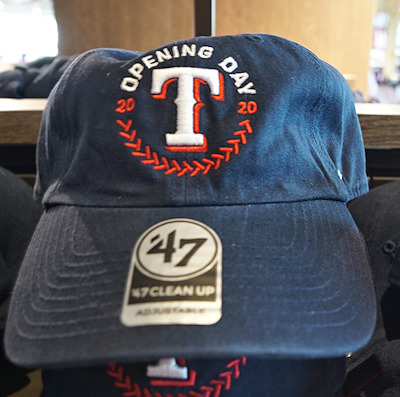 As for the prices, no surprise. They are high. Adult T-shirts are $35 and up, and for kids $24 and up. Polo shirts ranged from $95 to $118. Men’s adjustable caps are $30 and up, and fitted caps start at $45. Caps for women are $28-$35, and for kids $24 and up.
As for the prices, no surprise. They are high. Adult T-shirts are $35 and up, and for kids $24 and up. Polo shirts ranged from $95 to $118. Men’s adjustable caps are $30 and up, and fitted caps start at $45. Caps for women are $28-$35, and for kids $24 and up.
There’s good variety, but I was seeing mostly the same merchandise as I saw there during the previous fall’s NLCS and World Series.
No doubt, everyone wants to know about the concessions. Yes, there’s a lot more variety than at Globe Life Park, but I have to be honest with you, I was not overwhelmed. By no means would I put this in, say, the top five food parks in the Majors. That surprised me.
My favorite areas for concessions are:
- The food court behind third base on the main concourse — Chipper (baskets with corndogs for $10.75 and tenders for $10.50); Texas Fried ($10 burgers and $6 dogs); Cutter (sliced roast beef and turkey sandwiches for $11)
- In right-center field on the main concourse — personal favorite Pluckers (chicken wings in three flavors, $15 for six wing pieces with waffle fries); “24” (24-inch-long favorites like the $27.50 Boomstick); Lone Star Slice (10″ cheese or pepperoni pizzas for $10)
- Behind first base on the upper concourse, right in front of the all-you-can-eat dining space: Go Deep Fried (same corndogs and tenders as Chipper above) and Sweet Baby Ray’s (BBQ brisket sandwich for $10, smoked sausage for $11)
The Karbach Sky Porch on the upper concourse in the left-field corner has a menu not found elsewhere: smoked sausage on a bun for $12; brisket mac & cheese for $11; $10 brisket sandwich; $10 turkey leg; soft-serve ice cream for $8. But the lines were very long here.
In fact, it’s important to note that a sold-out crowd completely overwhelms the concession stands. Making matters worse is that COVID was preventing vendors from working in the stands, forcing everyone who wanted food or beer to go wait in line. By a couple of innings into the game, the waits were 20 minutes or more at most of the stands around the ballpark.
Most food stands also serve beer, with domestic drafts going for $7 for small, $11 for large and $15 for a stein. The most common beers I saw were Bud Light and Michelob Ultra, although the selection varied. Stands called Barrel Up and Truly serve mixed drinks in addition to beer, and the Crafthaus locations have wider varieties of beers.
And this is a Coke stadium, so Pepsi lovers are out of luck. Fortunately for Dr Pepper fans, it and Diet Dr Pepper are available. As you may know, Texans consume more Dr Pepper than either Coke or Pepsi.
  |
| Since I’m a big fan of the Pluckers chain around Texas, I made a beeline to their only stand at Globe Life Field. This is the $15 honey BBQ wings and waffle fries. Yes, they also have Buffalo flavor. |
So what did I eat on Opening Day? I went straight to the Pluckers stand. There’s only one in the stadium, and it’s in right-center field. I’m happy to report that the wings were on a par with what is served in the wonderful restaurants in Texas. Later I bought a pepperoni pizza at the Lone Star Slice stand on the upper concourse behind home plate. This was a mistake, because it was a greasy mess. Stadium food needs to be something you can eat on your lap at your seat, and this wasn’t it. I won’t be getting pizza again here.
The sound system is really good all around the park. There was no problem hearing the PA announcements. The pregame music mixed pop tunes, Country music — and most welcome of all — organ music! Call me old fashioned, but I think the beautiful sound of an organ is what should be heard at a baseball game.
Note, though, that when a Ranger hits a home run, the fireworks that exploded over the center-field building in the old park have been replaced by a cannon shot. It is LOUD.
The two video boards are simply enormous, and the resolution on them both is tremendous. Most of the time, they mirror the same image. The bigger one towers over right field. It’s shown below.
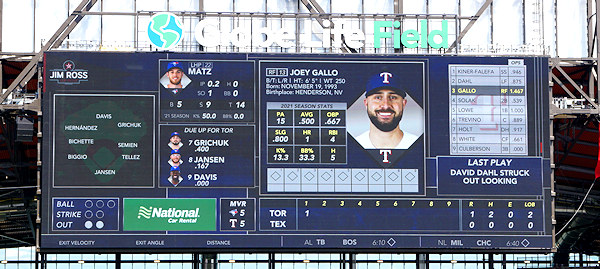
Because of the square footage of the screens, there is a tendency for there to be too much info on them. I’m surprised the player’s shoe size isn’t included with everything else. But if you want to keep up with how many mound visits a team has left or the exit angle of the most recent hit, it’s all there for you.
It’s probably not a fair assessment of a ballpark’s atmosphere to judge it on a sold-out Opening Day when local fans have been barred from attending any games at their new park for a year. But that day was magical and the fans were as pumped up as I’ve seen them since the 2011 World Series. They loved exploring all the nooks and crannies, just as Ortiz recommended.
They might not have been crazy about the prices of tickets, food and merchandise, but the creature comforts and the knowledge that they would be avoiding the unbearable summer temperatures put a lot of smiles on the fans’ faces.
Summary
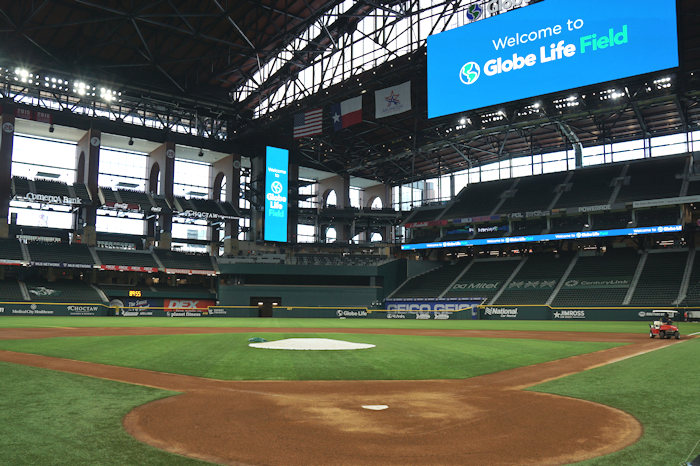
The address of Globe Life Field is 734 Stadium Drive. HKS’s Smith explains that a couple of years ago, the Rangers asked the architecture firm for suggestions for the street number on the already-existing Stadium Drive.
So Smith received a yell over his cubicle wall to start thinking about it. “First, I tried to see if we could change Stadium Drive to Ballpark Way and how the (street) numbers worked out, but changing the street name could have been a mess,” he explained. “When I checked the current block, it turned out to be the 700 block on the even side of the street. The first thing that came to me was 734 which ties to Pudge (Rodriguez) and Nolan (Ryan) of course. But since I was a kid, I’d thought of ‘734’ as Nolan’s seven no-hitters and his uniform number. It had been my lucky number for years.
“Also, 73 was my football number growing up, so that’s part of the tribute, too.”
So if you ever wondered how street numbers are dreamed up, now you know.
By the way, Smith received a personally autographed construction helmet from Nolan Ryan himself. On it, the Ryan Express thanked Smith “for the 734 tribute.”
There is certainly much to like at this modern marvel of planning and engineering. I feel the architecture is fantastic, the gameday experience is wonderful and the air conditioning is divine.
After a regular season where no fans were allowed at games, MLB devised a “bubble” concept for the 2020 playoffs, with the most important bubble being in Arlington. That’s because Globe Life Field was selected to host a National League wild-card round, an NL division round, the NLCS and the World Series. While there was no chance the last-place Rangers were going to crash the party and gain an unfair home-field advantage, a major reason this was done was so that the NLCS and World Series could accommodate a limited number of fans.
This permitted the LA Dodgers to roar through all four rounds of the post-season without having to change locales, grabbing the World Series championship on October 27 at Globe Life Field.
Ranger fans are hopeful that the next time there’s a World Champion crowned at 734 Stadium Drive, it will be by the team that helped pay to build the place.
Have something you want to say or ask about this review? Use the Comments box below.